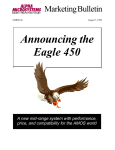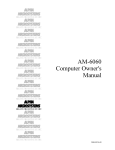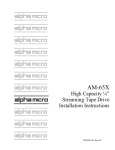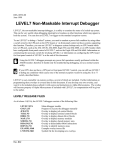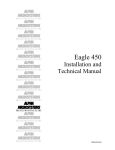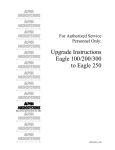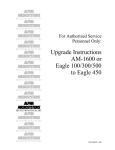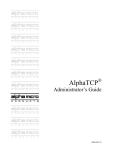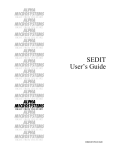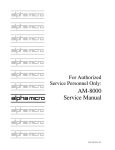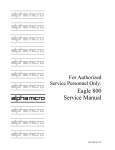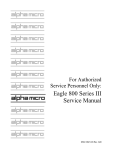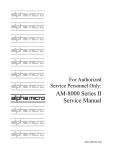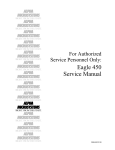Download Alpha Microsystems AM-6060 Specifications
Transcript
Marketing Bulletin AMB98-07 March 3, 1998 Announcing the AM-6060 Network Server New AM-6060 Network Server (far left, foreground) delivers MC68060-based processing power for AlphaTCP networks. Call us for the workstations too. Our AlphaDIRECT PCs (in photo, at right) offer top quality, custom integration, and total support from Alpha Micro. Contents Introducing the AM-6060 Network Server ................................................................................. 1 The System at a Glance .............................................................................................................. 2 Technology in the AM-6060 ...................................................................................................... 2 AM-6060 Network Server: Specifications and Configurations ................................................. 6 Ports ................................................................................................................................... 6 Memory ............................................................................................................................. 8 AM-6060 Chassis .............................................................................................................. 9 SCSI Busses ....................................................................................................................... 10 If You Order a Narrow SCSI System (SBC-06060-00): .......................................... 10 If You Order a Wide SCSI System (SBC-06060-01): .............................................. 10 Inefficient to Mix Wide and Narrow Disk Drives .................................................... 10 SCSI Devices — Support Considerations ......................................................................... 12 Wide SCSI Configuration Guidelines ...................................................................... 12 AM-441-00 Wide SCSI Bus Repeater ...................................................................... 12 Portable CD-ROM Players ....................................................................................... 12 RAID Disk Subsystem .............................................................................................. 12 AM-642 SCSI-to-Pertec Converter .......................................................................... 13 Other Installation Considerations ...................................................................................... 14 Serial Port Applications ............................................................................................ 14 Ethernet Features ...................................................................................................... 14 Surge Protection ....................................................................................................... 16 Printer Attachment Via Network Servers ................................................................. 16 Diskette Drives ......................................................................................................... 16 Year 2000 Compliance ............................................................................................. 16 Software ............................................................................................................................. 17 AMOS 2.3A Operating System ................................................................................ 17 TAME—TCP Management From Inside Your Application ..................................... 17 Factory-Installed Software ........................................................................................ 17 Upgrade to AM-6000 ......................................................................................................... 18 The UPG-66X60-01 Upgrade Kit ............................................................................. 18 System Performance .......................................................................................................... 18 System Index (SI) ..................................................................................................... 19 Serial Throughput vs. Network Throughput ............................................................. 20 AM-6060 vs. Other Networked Alpha Micro Computers ........................................ 22 Preconfigured Setup ........................................................................................................... 23 Specification for the Preconfigured INI File ............................................................ 23 Additional Specifications We Need From You ........................................................ 23 Running the Preconfigured System .......................................................................... 23 AM-6060 Network Server Configurator .................................................................. 25 The Bottom Line ................................................................................................................ 27 Tables Table 1. AM-6060 Memory Configurator......................................................................................8 Table 2. Choice of SCSI Busses in the AM-6060 Network Server ..............................................11 Table 3. External SCSI Cables ......................................................................................................13 Blank Form: AM-6060 Network Server Configurator ................................................ following p. 24 Click Here... Click this box on the home page at our www.amos-online.com Web site. You’ll find color pictures of the AM-6060 Network Server, summary specifications, and performance data for this exciting new product. Introducing the AM-6060 Network Server Dear Alpha Microsystems VAR: here was a time when every Alpha Micro user sat at an alphanumeric terminal with an RS-232 connection to an AMOS host. That picture has been changing for years, driven by networks, PCs, and an upheaval in marketing and distribution. Alpha Micro has introduced many products and services to help you stay close to this evolving market. Software such as AlphaNET and AlphaTCP; Ethernet controllers with steadily improving performance; and an infrastructure of network-knowledgeable support are but a few examples. T It’s now our privilege to announce a new system designed for networking: the Alpha Microsystems AM-6060 Network Server. • Fitted to the marketplace—The AM-6060 (pronounced Sixty-Sixty) is optimized for networking. Components, configurations, and plans for future enhancement are all directed toward one goal: delivering top performance at workstations networked to an AMOS host. • Compatible with current products—Power in the AM-6060 flows from the same MC68060based processor used in our AM-6000 system. A 32-bit bus-master Ethernet controller, with 10BaseT external port, is standard. Standard too is a 16-bit Wide SCSI bus that supports our full line of disks, tapes, and other SCSI peripherals. The AM-6060 is also available with a narrow SCSI bus, upgradeable to Wide SCSI when the need arises. • The right software—AlphaTCP 1.4, standard in the AM-6060, includes TAME—short for TCP Access Made Easy. TAME is a tool that lets you add TCP communications to any AlphaBASIC or AMOS assembly language application. This brings the networking power of TCP/IP to the heart of your business: your end-user applications. • Optimized for networks, adaptable for growth—Since it’s network-oriented, the AM-6060 differs from other Alpha Micro systems in one key respect: serial ports. The AM-6060 has just four, intended mainly for connection to high-speed modems. All other users connect via the network. Site requirements can change, of course, so the AM-6060 is designed to adapt. A field upgrade, installed inside the original chassis, converts the system into an AM-6000. Full serial port expandability is then available. • Superior performance—The AM-6060, like the AM-6000, is a performance powerhouse. Our benchmarks show TELNET sessions on the network delivering 50% more throughput than serial connections. See “System Performance,” later in the bulletin, for details. • Preconfigured for easier installation—To help first-time networkers get started, we ship the AM-6060 with the software configured and a PIC code installed. Plug in to the Ethernet, set up a workstation, and you’re ready to run. Our Technical Assistance Center can guide you through changes to tailor the system to site requirements. See “Preconfigured Setup” for an introduction. AM-6060 Network Server AMB98-07 Page 2 ________________________________________________________________________________ The System at a Glance The block diagram in Figure 1 shows the principal features of the AM-6060. This is an introductory view. Details are presented later. ➀ Chassis—The AM-6060 comes in a new, attractively styled deskside chassis. There’s room inside for CPU components and a mix of disks, tapes, and other peripherals. A Wide SCSI bus is standard in one AM-6060 model. ➁ Ethernet—A 10BaseT Ethernet port, backed by AlphaTCP and other standard networking software, connects the AM-6060 to user workstations, WANs, the Internet, and so on. ➂ Serial ports—Four RJ-45 serial ports, with full modem control, are standard. Most AM-6060 sites will use one, and often two, of the ports for modems. More information on serial port usage appears later in the bulletin. ➃ External SCSI port—Attach a RAID subsystem, a ½-inch tape controller, and other devices at the external SCSI port. ➄ Upgrade to AM-6000—A field upgrade kit converts the AM-6060 in its original chassis to an AM-6000 Business System. Optional AM-359 cards in the AM-6000 provide a total of more than 50 serial ports. The four standard serial ports in the AM-6000 replace the four serial ports originally installed in the AM-6060 (➂ above). Technology in the AM-6060 The central processing unit of the AM-6060 consists of a main processor board and a small plug-on auxiliary board. The processor board is identical to the Roadrunner 060 board in the AM-6000. The auxiliary board, model AM-301-10, is a new product. The technology and functional specifications for the AM-6060 main processor board are the same as those announced earlier for the AM-6000. Differences in SCSI configurations are noted in the following description: Superscalar CPU At the heart of the AM-6060 main processor is a Motorola MC68060 microprocessor. The 68060 offers superscalar integer performance of over 100 MIPs at 66MHz. (“Superscalar” here means the CPU can execute two scalar instructions, such as multiplying one number by another, simultaneously.) This performance far exceeds that of any prior 680X0 microprocessor. The MC68060 includes two 8KB on-chip caches for fast access to instructions and data. External Cache The AM-6060 main processor is equipped with 64KB of external cache, mounted on a small plug-in circuit card. [Text continued on page 4] AM-6060 Network Server AMB98-07 Page 3 ________________________________________________________________________________ ➀ AM-6060 in Deskside Chassis ➁ AM-6060 Network Server ● ● ● ● ● ● Ethernet Port, 10BaseT WS 68060 CPU Wide SCSI Disks Tapes CD-ROM AM-441 SCSI Repeater WS WS ➂ Four Serial Ports Boot Terminal Typical Attached Devices Modem Modem ➃ External SCSI Port External SCSI Devices ● ● ● RAID Subsystem ½" Tape Drive Other Serial Ports (AM-359) added in upgrade Optional Upgrade to AM-6000 System ● 50+ ports in original AM-6060 chassis ● 200+ ports with expansion chassis Four Parallel Ports added in upgrade P P P P ➄ WS Workstation P Field Upgrade to AM-6000 Business System Printer Figure 1. AM-6060 Network Server: Block Diagram AM-6060 Network Server AMB98-07 Page 4 ________________________________________________________________________________ Memory The AM-6060 accommodates main memory from 8MB to 256MB. Four SIMM sockets are provided, the same as in the AM-6000. Configurations range from 8MB (two 4MB SIMMs) to 256MB (four 64MB SIMMs). The arrangement is versatile and easy to upgrade. For details see the AM-6060 Memory Configurator on page 8. SCSI Support SCSI device support begins at a 32-bit bus-master SCSI controller on the AM-6060 main processor board. As standard, the board provides two interfaces to the controller. One is a 50-pin standard (“narrow”) SCSI interface, the same as provided in Eagle systems and on Roadrunner 030 and 040 boards. The other is a 68-pin Wide SCSI interface, as on the Roadrunner 060 board. Disk drives, tape drives, and other SCSI peripherals connect to the controller via SCSI bus cabling. The AM-6060 is offered in two versions: one with a narrow (8-bit) SCSI bus cable and the other with a WideSCSI (16-bit) cable. A system ordered with narrow SCSI can be field-upgraded to Wide SCSI when the need arises. Characteristics of the two busses are as follows: • The Narrow SCSI bus supports SCSI-2 disk drives, as used in Eagle systems and Roadrunner 030- and 040-equipped systems today. The bus also supports streamer tapes, DAT tapes, CD-ROMs, and the AM-642 SCSI-to-Pertec Converter for ½" tape drives. The bus is one byte wide (8 bits plus parity) and supports a maximum transfer rate of 10 megabytes per second. Physically, the narrow bus is a 50-conductor flat cable about 2½ inches wide. • The Wide SCSI bus provides twice the data width: two bytes, or 16 bits. Doubling the width of the data path doubles the maximum transfer rate to 20 MB per second. The bus originates at the 68-pin connector on the processor board. Wide SCSI (“Fast-Wide SCSI-2”) and Ultra SCSI peripherals attach directly to the bus. Narrow SCSI peripherals connect via 50-pin-to-68-pin adapters. For configuration guidelines see “SCSI Busses” later in this bulletin. The Wide SCSI bus cable is a 68-conductor flat cable about 1¾ inches wide. It’s a miniaturized design, so it’s physically smaller than the narrow SCSI cable. • Additional SCSI peripherals can be located outside the AM-6060 chassis and connected by external cables. See “SCSI Busses” for configuration guidelines. The optional AM-441 Wide SCSI Bus Repeater provides added flexibility in the number and location of external devices. Disk-intensive applications are potentially faster with the Wide SCSI bus and a Wide SCSI disk drive. Wide SCSI also has the advantage in multi-disk configurations. Spreading a file and its index across two Wide SCSI disks, for example, boosts the performance advantage of each disk. AM-6060 Network Server AMB98-07 Page 5 ________________________________________________________________________________ 10 Mbps Ethernet The AM-6060 main processor board includes a 32-bit, bus master Ethernet Controller, capable of communicating at up to 10 megabits per second. Technical features include a 33MHz bus clock and two independent 32-byte FIFO buffers. A 10BaseT Ethernet connector is furnished as standard on the rear of the chassis. 100 Mbps Fast Ethernet In its 100BaseT implementation, Fast Ethernet moves data at up to 100 megabits per second over Category 5 twisted pair cabling. We plan to introduce support for Fast Ethernet on future releases of AM-6060 hardware and software. See “Ethernet Features” below for further information. AM-301-10 Auxiliary Board The AM-301-10 Auxiliary Board is a small plug-on card that attaches to a connector on the main processor board. (The connector was included in the original design of the processor in anticipation of applications such as the AM-6060.) The AM-301-10 accommodates the four RJ-45 serial ports, the SSD chip, the real time clock, and other CPU-related components. Operating System The AM-6060 runs under AMOS 2.3A and later versions of the AMOS Operating System. Network Software The AM-6060 supports a full repertoire of networking and communication software. AlphaTCP, AlphaNET, and AlphaDDE are furnished as standard. Optionally available packages include AlphaLAN and VersiCOMM-Plus, as well as products from third-party suppliers to the AMOS community. AM-6060 Network Server AMB98-07 Page 6 ________________________________________________________________________________ AM-6060 Network Server: Specifications and Configurations Specifications for the AM-6060 are as follows. Ports Ports for connection to modems, an Ethernet network, and other functions are provided on the rear panel of the AM-6060. Figure 2 shows details. Four RJ-45 serial ports—Serial ports on the AM-6060 provide full modem control, Super I/O compatibility, and built-in lightning protection. Pinouts are the same as those on the AM-359 Serial I/O Expansion Card. The ports are mounted on an AM-90 Lightning board. An array of zener diodes on the board guards against voltage surges caused by lightning strikes, accidental power line crossings, and other damaging electrical fluctuations. See “Surge Protection” on page 16 for specifications of this feature. In the AM-6060 environment, users are supported at networked workstations. For that reason the AM-6060 does not provide serial port expansion beyond the four ports furnished as standard. For application suggestions see “Serial Port Applications” on page 14. 10BaseT Ethernet port—Standard feature of the AM-6060. A DB-15 AUI port can be substituted for installations that require ThinNet or Thick Ethernet cabling. External SCSI connector—An external SCSI device cable, or a SCSI terminator, attaches to this port. An AM-6060 ordered in the Wide SCSI configuration comes equipped with a 68-pin “P” connector; a narrow SCSI system has a 50-pin Centronics-type connector. The appropriate style of SCSI terminator is furnished in each case. RS-232 Diagnostic Interface—This female DB-9 is cabled internally to the AM-6060 main processor board. The port is not configurable at this time and no attachment should be made. A parallel printer port is planned as an optional feature for future AM-6060 systems. AM-6060 Network Server AMB98-07 Page 7 ________________________________________________________________________________ ➂ External SCSI Port ➁ 10 BaseT Ethernet Port ➃ RS-232 Diagnostic Interface (not configurable on initial product release) ➀ Four RJ-45 serial ports with full modem control and lightning protection Figure 2. Ports on the AM-6060 Rear Panel AM-6060 Network Server AMB98-07 Page 8 ________________________________________________________________________________ Memory The AM-6060 supports a minimum of 8MB and a maximum of 256MB of main memory. Memory is implemented in SIMM modules of 4MB, 8MB, 16MB, 32MB, and 64MB each, installed in sockets on the AM-6060 main processor board. Four sockets are provided. SIMMs are always installed in pairs: two 4MB SIMMs, or two 8MB SIMMs, and so forth. Use PFB-00712-XX 60ns SIMMs. Table 1 below, the AM-6060 Memory Configurator, shows all allowable SIMM combinations. Table 1. AM-6060 Memory Configurator Install these memory SIMMs... ↓ ↓ PFB-00712-04 4MB Memory, 60ns PFB-00712-08 8MB Memory, 60ns PFB-00712-16 16MB Memory, 60ns PFB-00712-32 32MB Memory, 60ns PFB-00712-64 64MB Memory, 60ns ... to obtain this amount of Main Memory 8 16 16 24 32 32 40 48 64 64 72 80 96 128 128 136 144 MB MB MB MB MB MB MB MB MB MB MB MB MB MB 2 *4 2 *2 2 2 4 2 2 2 2 2 4MB Memory, 60ns PFB-00712-08 8MB Memory, 60ns PFB-00712-16 16MB Memory, 60ns PFB-00712-32 32MB Memory, 60ns PFB-00712-64 64MB Memory, 60ns * 2 2 2 2 2 4 2 MB MB 2 2 2 2 MB 2 4 2 MB MB 2 160 192 256 PFB-00712-04 MB 4 Example—You can make a 16MB system with four 4MB SIMMs or two 8MB SIMMs. One 16MB SIMM will not work. Two or four SIMMs must always be installed. 2 2 AM-6060 Network Server AMB98-07 Page 9 ________________________________________________________________________________ AM-6060 Chassis The AM-6060 is furnished in an attractively styled deskside mini-chassis. It resembles, in size and general arrangement, the Eagle chassis we’ve been shipping in recent years. Differences in styling give the AM-6060 a streamlined, contemporary appearance. A redesigned front panel diagnostic display, specially engineered for AMOS-based applications, occupies one 1-inch high peripheral device bay. Specifications for the chassis are as follows: • Dimensions—17¾" high x 9" wide x 17" deep (44.5 cm x 22.9 x 43.1) • Power requirement—5 amp @ 115VAC; 2.5 amp @ 230VAC • Peripheral mounting—The AM-6060 chassis accommodates up to six peripheral devices. Figure 3 shows details. Three 5.25" device bays, all front-accessible. Reserved for front panel display One 3.5" device bay, front-accessible Two 3.5" device bays, hidden Cutaway view from left side Figure 3. AM-6060 Chassis: Peripheral Mounting Bays AM-6060 Network Server AMB98-07 Page 10 ________________________________________________________________________________ SCSI Busses As explained earlier, the AM-6060 Network Server is equipped with two SCSI busses: the 50-pin SCSI bus and the 68-pin Wide SCSI bus. Each bus originates at a connector on the main processor board. A flat cable runs from the bus connector to SCSI devices inside the chassis. • A 50-conductor SCSI cable is furnished when the AM-6060 is ordered as part number SBC-06060-00. This is the same type of SCSI cable used in our Eagle systems, in Roadrunner 030 and 040 systems, and in the AM-4000. • A 68-conductor Wide SCSI cable is furnished when the AM-6060 is ordered as part number SBC-06060-01. The two bus cables are mutually exclusive. That is, the SCSI devices in the system must all be connected to the 50-pin SCSI bus, or all to the 68-pin Wide SCSI bus. Mixes, with some devices on one bus and some on the other, are not supported. Table 2 opposite summarizes the characteristics of the two busses. If You Order a Narrow SCSI System (SBC-06060-00): An AM-6060 in the narrow SCSI configuration supports our familiar SCSI-2 disk drives (part number PDB-00436-XX), tape streamers, DATs, and other narrow SCSI peripherals. The system will also accept Wide SCSI devices. Examples include Fast-Wide SCSI-2 disks, such as our PDB-00440-XX 2.1GB and 4.3GB drives, and the 26GB ¼-inch cartridge tape streamer. Each such device requires a PDB-00440-90 Adapter to mate with the 50-pin SCSI cable. In this environment, Fast-Wide devices will perform at about the same speed as narrow SCSI-2 devices. If You Order a Wide SCSI System (SBC-06060-01): For maximum system throughput, order the AM-6060 in the Wide SCSI configuration. Data moves in and out of the disk buffers faster because the interface to the system is 16 bits wide, instead of the 8-bit path used in SCSI-2 drives. The Wide SCSI bus cable provides 68-pin connectors that mate directly with the 68-pin connectors on Fast-Wide SCSI-2 devices. The Wide SCSI bus also accommodates Ultra SCSI disk drives. With present AM-6060 hardware and software, Ultra SCSI drives provide the same performance as Fast-Wide SCSI-2 disk drives. When you order a Wide SCSI AM-6060, you’ll also need to order a PDB-00440-91 Adapter for each narrow SCSI-2 device, such as a 525MB or other prior model tape streamer. The adapter is a 50-to-68-pin width-changer that lets narrow devices connect to the wide bus. Inefficient to Mix Wide and Narrow Disk Drives It is technically feasible to connect a mix of SCSI-2 disk drives and Fast-Wide SCSI-2 disk drives to the Wide SCSI bus. A performance penalty is paid, however, because the relatively long time-onthe-bus for the SCSI-2 disks keeps the Fast-Wide disks off the bus that much longer. To get the full benefit of Wide SCSI, use Wide SCSI disks exclusively. AM-6060 Network Server AMB98-07 Page 11 ________________________________________________________________________________ Table 2. Choice of SCSI Busses in the AM-6060 Network Server Narrow SCSI Bus Wide SCSI Bus Availability in the AM-6060 Standard in SBC-06060-00 AM-6060 Network Server Standard in SBC-06060-01 AM-6060 Network Server, Wide SCSI Optional upgrade for SBC-06060-00 Bus Width One byte (8 bits + parity) Two bytes (16 bits + parity) Bus Connectors 50-pin 68-pin Maximum Transfer Rate 10 Mbytes/sec 20 Mbytes/sec Max. Number of Connected Devices 7 total, including internal and external devices Internal: 5 devices, maximum External: Depends on cable length; up to 8 feet allowed with AM-441 SCSI Repeater. How Peripherals Connect to the Busses: Devices with 50-pin SCSI Connector • • • • SCSI-2 disks (“narrow disks”) Streamer tapes, 2GB or less DAT tapes Other standard SCSI-2 devices Devices with 68-pin Wide SCSI Conn. These devices connect directly to the SCSI bus, same as in Roadrunner 030 and 040 systems, Eagles, and AM-4000 Each device requires a Each 50-pin device requires a PDB-00440-91 Adapter to connect to the Wide SCSI bus. Since these devices have a 68-pin data connector, they connect directly to the 68-pin Wide SCSI bus. • Fast-Wide SCSI-2 or UltraSCSI disks • 26GB ¼" streamer tape PDB-00440-90 Adapter to connect to the SCSI bus. What happens when wide and narrow disk drives are mixed in the same system? Wide SCSI disks are no faster than narrow disks. Wide SCSI performance advantage is sacrificed. See text on opposite page for explanation. External SCSI Connector 50-pin connector, same as in Roadrunner 030 and 040 systems, Eagles, and AM-4000. Installation kit includes 50-pin SCSI terminator. 68-pin Wide SCSI external connector. Installation kit includes 68-pin Wide SCSI Active Terminator. Your Decision: The AM-6060 Network Server is available with either bus style. We recommend the following for maximum performance: • Order the Wide SCSI configuration: SBC-06060-01. • Order Wide SCSI disk drives (part number PDB-00440-XX). • Order a PDB-00440-91 Adapter for each narrow SCSI device in the system. AM-6060 Network Server AMB98-07 Page 12 ________________________________________________________________________________ SCSI Devices—Support Considerations Wide SCSI Configuration Guidelines A Wide SCSI AM-6060 supports up to five internal SCSI devices, mounted inside the system chassis. See “AM-6000 Chassis,” above, for mounting locations. Additional SCSI devices can be installed outside the chassis. Configuration guidelines are as follows: 1. With a standard Wide SCSI AM-6060, the maximum length of external cabling, starting from external SCSI connector on the chassis, is three feet (91 cm). In practice that usually means a maximum of one external device. 2. Adding an AM-441-00 Wide SCSI Bus Repeater increases the maximum external cable length to eight feet (243 cm). That amount of cabling will normally allow up to three external devices. 3. If the external devices include a mix of Wide SCSI and narrow SCSI, the narrow devices must be grouped at the outboard end of the cabling, farthest from the chassis. 4. An external cable is standard with some devices and optional with others. We offer the cables listed in Table 3. If you plan to supply your own cables, make sure they’re fabricated to SCSI-2 construction standards. Points to keep in mind for particular devices are noted below. AM-441-00 Wide SCSI Bus Repeater The AM-441 is a booster that electronically extends the Wide SCSI bus. The AM-441 occupies one 5.25" peripheral device bay in the AM-6060 chassis. For further information see Marketing Bulletin AMB98-04, New Wide SCSI Versatility—Shipping Now, January 23, 1998. Portable CD-ROM Players Many Alpha Micro VARs and developers use a portable CD-ROM player to load software at customer sites. If you do, you’ll need a 68-pin cable to connect to a Wide SCSI AM-6060. Order a PDB-00440-81 External SCSI cable (50-pin Centronics connector to 68-pin External SCSI, 3 ft) and keep it with the CD-ROM player. Do not use a cable longer than three feet unless the AM-6060 is equipped with an AM-441-00 Wide SCSI Bus Repeater. RAID Disk Subsystem The AM-6060 supports the AM-446 RAID Subsystem. The AM-446 is a Wide SCSI external device. Accessory kits offered for the AM-446 include the appropriate external cable. The cable is three feet long; equipment layout of the AM-6060 chassis and the RAID subsystem chassis should be planned accordingly. For details see Marketing Bulletin AMB97-41, AM-446 RAID Subsystem Announced, December 22, 1997. AM-6060 Network Server AMB98-07 Page 13 ________________________________________________________________________________ Table 3. External SCSI Cables Use This Cable to Connect Chassis to Device External SCSI Connector on AM-6060 Chassis Connector on External SCSI Device Cable Part Number 68-pin 50-pin PDB-00440-80 Cable, 50-pin Centronics to 68-pin External SCSI, 3 ft. 68-pin 50-pin PDB-00440-81 Cable, 50-pin Centronics to 68-pin External SCSI, 6 ft.* 68-pin 68-pin PDB-00440-82 Cable, Wide SCSI, 68-pin/Male, 68-pin Male * Description To use a 6 ft. cable and keep within Wide SCSI cable guidelines, an AM-6060 must be equipped with an AM-441-00 Wide SCSI Bus Repeater. ________________________________________________________________________________ AM-642 SCSI-to-Pertec Converter The AM-642 is a family of interface units that connect an AMOS-based host system to a Perteccompatible ½" tape drive. The external version, Model AM-642-00, is mounted in a desktop chassis and cabled to the host. Cabling arrangements are as follows: • With a Narrow SCSI AM-6060—The AM-642-00 comes with a 3 ft. (0.9m), 50-conductor cable. Plug the cable to the external 50-pin SCSI connector on a narrow SCSI AM-6060. • With a Wide SCSI AM-6060—For a Wide SCSI AM-6060, order one of the following SCSI cables to connect the AM-642 to the Wide SCSI external connector on the system chassis: - PDB-00440-80 Cable, 50-pin Centronics to 68-pin External SCSI, 3 ft. - PDB-00440-81 Cable, 50-pin Centronics to 68-pin External SCSI, 6 ft. To use the 6 ft. cable, the system must be equipped with an AM-441-00 Wide SCSI Bus Repeater. An internally mounted version of the AM-642 is also manufactured, but is not installable in the deskside chassis. AM-6060 Network Server AMB98-07 Page 14 ________________________________________________________________________________ Other Installation Considerations Serial Port Applications Since the AM-6060 is a network server, users interact with the system through network workstations rather than serially connected terminals. The four RJ-45 serial ports on the AM-6060 are intended for other functions. Applications will vary from site to site, but the following can be taken as typical: Port #1: System console terminal—Connect an AM-65 to this port. Use it to bring up the system. Keep it available for performing tests independently of the networking hardware and software. Port #2: High-speed modem—Many large AMOS-based system support remote sites via modems. The RJ-45 ports on the AM-6060 provide full modem control. Port #3: High-speed tech support modem—An indispensable tool for system update and diagnosis from a remote test center. Port #3: Various—Depending on local requirements, a port might be used for a serialinterface printer, for another modem, for UPS monitoring, or other functions. Ethernet Features Ethernet connectivity is an integral feature of the AM-6060 main processor board. Ethernet-related components on the board are highlighted in Figure 4. A 10BaseT Ethernet port (RJ-45 jack) is standard. Mounted in a cutout on the rear panel of the system chassis, the jack connects to the processor board via an internal cable. At present, the AM-6060 supports Ethernet transmission at 10 megabits per second. Fast Ethernet (100BaseT), with transmission at 100 Mbps, is planned as an optional feature on a future release. The feature will consist of a plug-in card connected to the Expansion Bus connector already present on the processor board. See Figure 4. Attachment points for mounting the 100BaseT card inside the chassis are also present in every AM-6060 system. AM-6060 Network Server AMB98-07 Page 15 ________________________________________________________________________________ Visit our new AMOS Web site, www.amos-online.com, for a guided tour of all the components on this processor board. Click the AM-6000 photo on the home page to get started. MC68060 Microprocessor (mounted below cooling fan) AM-6060 Processor Expansion Bus— Optional Fast Ethernet controller will connect here 10BaseT Ethernet Controller—10 Mbps Connector for cable to 10BaseT port on rear panel of chassis Figure 4. Ethernet Features on AM-6060 Main Processor Board AM-6060 Network Server AMB98-07 Page 16 ________________________________________________________________________________ Surge Protection The serial ports in the AM-6060 provide surge protection as a standard feature. Protection is implemented by an array of zener diodes, sometimes called avalanche diodes. The diodes are mounted on the AM-90 Lightning board to which the four RJ-45 jacks are physically attached. If an over-voltage condition occurs on the serial I/O cable, the diodes react—in nanoseconds—to divert the flow of current away from sensitive I/O circuitry. A system that’s installed and grounded in accordance with Alpha Micro standard practice should withstand virtually any power surge without damage. However, the exact characteristics of power surges are difficult to predict. (Consider what can happen, for example, when a high-voltage power line comes loose in a storm and drops across telephone wires carrying modem traffic.) The presence of the surge protection feature, therefore, does not affect our warranty coverage. An AM-90 Lightning board protects the system inside which the board is installed. Surge protection for terminals or other far-end devices, if desired, must be implemented by other means. Printer Attachment via Network Servers In AM-6060 environments, network printer servers offer a convenient way to attach printers with no need for serial or parallel ports. The network printer server operates as a node on the TCP/IP network, with its own IP address. Some printer servers are pocket size units, with a DB-25 connector for attachment to the printer and a 10BaseT jack for the network. Other models, slightly larger, provide ports for two printers or more. Diskette Drives When an AM-6060 requires floppy disk I/O, make arrangements to read or write the floppy in a computer elsewhere on the network. That computer can be another Alpha Micro system, or a PC, or any other computer that’s capable of networking to the AM-6060. The AM-6060 itself does not provide for attachment of a diskette drive. However, if the system is upgraded to an AM-6000, an AM-219 Floppy Disk Controller and a diskette drive can be installed in the normal manner. Year 2000 Compliance When used with the AMOS 2.3A operating system, the AM-6060 is Year 2000 compliant. Information about Year 2000 compliance of other hardware and software products appears in marketing bulletins entitled Progress Report on Year 2000 Compliance, published by Alpha Microsystems from time to time. AM-6060 Network Server AMB98-07 Page 17 ________________________________________________________________________________ Software AMOS 2.3A Operating System The AM-6060 runs under AMOS 2.3A and later versions of the AMOS operating system. The AM-6060 configurations defined by part numbers SBC-06060-00 and -01 include an AMOS license. Further information appears in the Reseller Supplement. If your application is running under an earlier release and you’d like help in moving to a networked environment, please call the Technical Assistance Center. We’re here to help you add still greater value to your application in the Alpha Micro world. TAME—TCP Management From Inside Your Application The network software furnished with the AM-6060 includes AlphaTCP 1.4, the latest version of our AMOS-compatible implementation of the TCP/IP protocol family. AlphaTCP 1.4 in turn includes TAME, for TCP Access Made Easy. TAME lets you add TCP communication to any AlphaBASIC or AMOS assembly language application. To access TCP from an assembly language program, you use a series of monitor calls. From AlphaBASIC or AlphaBASIC PLUS, you use the new TCP XCALL subroutine. AlphaTCP 1.4 software and documentation are available on the December 1997 AlphaCD. Documentation is also available at our Web site. See the latest revisions of the AMOS Monitor Calls Manual and the AlphaBASIC XCALL Subroutine User’s Manual. Also standard in the AM-6060 are the latest revisions of AlphaNET and AlphaDDE. Factory-Installed Software To help get your installation on the air, even if you’re a networking novice, the AM-6060 is delivered with software already configured and ready to run. More information about this software appears on page 23, “Preconfigured Setup.” The specifics of your network, your file structure, and other site-dependent details may dictate changes in the factory-installed setup. Call the Technical Assistance Center if you need help. They know how the preconfigured setup works, so they have a headstart on helping you create a custom fit to your exact needs. AM-6060 Network Server AMB98-07 Page 18 ________________________________________________________________________________ Upgrade to AM-6000 If site requirements should outgrow the resources of an AM-6060 Network Server, the system can easily be field upgraded to an AM-6000 Business System. The upgrade is accomplished by adding components inside the chassis and changing out the rear panel. The original chassis remains installed. The upgrade provides these benefits: • Serial ports—In place of the four (maximum) serial ports in the AM-6060, the AM-6000 provides four standard ports plus paddle card busses that support AM-359 8-port Serial I/O cards. The chassis accommodates up to six cards, for a total of 52 ports, including the four furnished as standard. With the addition of external expansion units, the total complement can grow to over 200 ports. • Parallel ports—The upgrade adds four DB-25 parallel printer ports. • Diskette configurability—The AM-6000 supports the AM-219 Floppy Disk Controller, which in turn supports one or two diskette drives. The UPG-66X60-01 Upgrade Kit To upgrade an AM-6060, order the UPG-66X60-01 Upgrade Kit. The kit contains: • AM-319-20 System Board, with parallel ports and paddle card serial I/O busses • Replacement rear panel for the AM-6060 Network Server chassis • Cabling, mounting hardware, and installation instructions Installation consists principally of removing the small AM-301-10 daughter board attached to the AM-6060 main processor; installing the AM-319-20 System Board; and changing out the rear panel of the chassis. When finished, disconnect the serial cables originally connected to the four ports on the AM-301-10 auxiliary board and reconnect them to the four serial ports on the AM-319-20. The upgrade does not change the SCSI level of the system. A narrow SCSI AM-6060 becomes a narrow SCSI AM-6000, and a Wide SCSI AM-6060 becomes a Wide SCSI AM-6000. System Performance The AM-6060 is inherently fast because it’s built around the fastest processor we’ve used in the 20-year history of Alpha Micro—the Motorola MC68060. This powerful CPU can deliver superscalar performance of over 100 million operations per second. How does that translate to responsive screen handling at workstations on a network? For the most accurate answers, run your application on an AM-6060 and measure the results. If that isn’t practical, benchmarks can provide a relative measurement. Benchmarks let you compare the AM-6060 with earlier Alpha Micro computers with which you’re already familiar. AM-6060 Network Server AMB98-07 Page 19 ________________________________________________________________________________ The benchmarks in this bulletin are offered for general comparison analysis and example only. For definitive measurements, VARs and end users should verify actual performance based upon their specific applications and environments. The benchmarks we use give an overall indication of system throughput. It’s important to note that the way your application software uses the system may produce results different from those suggested by our benchmarks. System Index (SI) The SI benchmark measures processor and memory performance in the 680X0 environment. The measure is relative to the original WDC-based Alpha Micro computer, the AM-100, which was arbitrarily assigned an SI of 1. See the table below; bigger numbers are better. As shown on the bottom line of the table, the AM-6060 yields an SI value of 137.0. Compare that with the 79.9 measured on an Eagle 500, a few lines above. The Eagle 500 is installed as a network server at many sites. Measured by the SI test, strictly as one processor against the other, the AM-6060 is more than 70% faster than the Eagle 500. Keep in mind that the SI reflects processor speed only, not overall system performance as users will experience it. Factors such as disk accessing and the effect of multiple users are not measured. For a more comprehensive view, see the DOABEN benchmark on the next page. System Index (SI) Benchmark Results for Various Alpha Micro Systems System Model AM-100 ➩ ➩ CPU WDC_Chips 48-bit Floating Point SI Compute Index 1 1 AM-1400 12MHz 68010 6.1 6.0 AM-1600 25MHz 68020 22.6 22.3 Falcon/AM-PC 16MHz 68340 16.1 16.0 Eagle 300 40MHz 68030 39.1 38.4 AM-3000 VME 50MHz 68030 43.6 42.7 AM-4000M 66MHz 68040 66.1 64.1 Eagle 500 80MHz 68040 79.9 76.9 Super Eagle 80MHz 68040 79.9 76.9 AM-6000 (RR 060) 66MHz 68060 137.0 128.1 AM-6060 66MHz 68060 137.0 128.1 AM-6060 Network Server AMB98-07 Page 20 ________________________________________________________________________________ Serial Throughput vs. Network Throughput Alpha Micro computers are more efficient in processing data for remote workstations than for cableconnected terminals. You can see the difference in the DOABEN tests charted below. DOABEN (do a benchmark) is a suite of tests that measure multi-user throughput on Alpha Micro computer systems. Performance is measured in units called Milestones, which represent the number of tasks that can be done in a certain period of time for a prescribed number of users. Programs in the DOABEN suite exercise the system by cycling through functions such as database access, program loading, and CPU usage. In the tests charted on the next page, we loaded the system by superimposing a selected set of background tasks onto the normal DOABEN suite. In two cases the background tasks were remote jobs, running as TELNET sessions over a network. In the other two cases, the system was loaded by serial tasks, simulating users at RS-232 terminals. As shown on the chart, the system delivered far higher Milestone throughput rates with remote loading (“20 REMOTE” and “40 REMOTE”) than with serial loading. Two conclusions are apparent: 1. For a given level of throughput, an Alpha Micro computer will support more users on a network than it will at local terminals. 2. The system handles increases in remote loading much more efficiently than increases in serial loading. As you can see on the chart, Milestones for remote users remained in the 1500 to 1600 range, even with a doubled workload. With serial users, on the other hand, doubling the load triggered a plunge in Milestones, from around 1400 to around 1000. The lesson is: If efficient use of system resources is a goal, and you have a choice between AlphaTCP and RS-232, the network gives more value for the money. AM-6060 Network Server AMB98-07 Page 21 ________________________________________________________________________________ The DOABEN Contrast: Serial Users vs. Remote Users High Milestone ratings when added users are REMOTE DOABEN Benchmark: Remote vs. Serial Users 1800 1700 1600 Milestones 1500 1400 20 Remote 40 Remote 20 Serial 40 Serial 1300 1200 1100 1000 900 800 1 3 5 7 9 11 13 15 17 19 21 23 Number of Users Low Milestone ratings when added users are LOCAL Configuration Notes 1. Tests were run on an AM-6000 system equipped with Wide SCSI bus and 7200 RPM Wide SCSI disk drive. REMOTE loads were added by programs running in a second AM-6000, networked and serial-cabled into the test system. 2. This benchmark demonstrates that more time is available to the CPU for job processing due to lower interrupt overhead. The benchmark does not address terminal throughput. AM-6060 Network Server AMB98-07 Page 22 ________________________________________________________________________________ AM-6060 vs. Other Networked Alpha Micro Computers AM-6000: 70% more network throughput than an Eagle 500 Ethernet Throughput Relative Speed 300 250 200 Series1 150 Series2 100 50 0 144.74 Eagle 500 146.23 150.51 155.47 System 220.21 Eagle Super 206.54 210.38 210.38 Model 227.28 AM-6000 (Same278.9 network speed as the AM-6060) 233.85 278.78 Innovative design and a fast CPU give our 68060-based systems a speed advantage over all prior Alpha Micro computers. The advantage is apparent in many areas of system operation, including network throughput. The chart above shows the average of several network performance tests we ran to compare an AM-6000 with a Super Eagle and an Eagle 500. (An AM-6060 will give essentially the same performance as an AM-6000.) The Eagle 500 is the server workhorse in many AlphaTCP networks. As shown in the chart, an AM-6000 outran the Eagle 500 by more than 70%. AM-6060 Network Server AMB98-07 Page 23 ________________________________________________________________________________ Preconfigured Setup We ship the AM-6060 with preconfigured software, ready to plug in and run. The software includes the AMOS 2.3A operating system; AlphaTCP; and a system initialization command file (“INI file”) already modified to work with AlphaTCP. The preconfigured setup is furnished as a tool for your use, as you choose to use it. You can use the preconfigured software for the user’s own system installation; or modify it; or use it simply for out-of-box testing; or ignore it altogether. Specification for the Preconfigured INI File The complete preconfigured INI file will be available for download from the Alpha Microsystems FTP server. The file implements the following functions: • • • • TCP is installed The TELNET daemon is installed System configured for 16 users at 200K bytes per user (the INI includes samples of code to specify a different number of users and a different amount of memory per user) Default log-in procedures Additional Specifications We Need From You We will set the system for a specific IP address and a specific default name. You’ll probably need different ones when you install the system. Give us the necessary information and we’ll pre-install the name and IP address of your choice. Use the AM-6060 Network Server Configurator form. There’s a blank copy on the next page. Running the Preconfigured System The preconfigured software, as you see it on our FTP site, gives a system that is ready to run, out of the box. Make a network connection to a workstation and you’ll be ready to operate. This facility provides a quick, straightforward way to verify the integrity of the combined hardware/software/ network assembly. You can go forward with confidence to any necessary customization. AM-6060 Network Server AMB98-07 Page 24 ________________________________________________________________________________ (This page intentionally left blank) AM-6060 Network Server Configurator Using This Configurator With the information you supply on this configurator, we’ll be able to finish setting up your AM-6060 Network Server before shipment. Fax the completed form to Order Administration at (714) 641-7676. ☛ Need technical assistance? Fax this form, with questions, to (714) 641-7605 or call (800) 487-7877. Date _______________ Dealership Name ________________________________________________________ Dealer No. ___________ Your Name __________________________________________________________________________________ Phone ______________________________________ Fax __________________________________________ E-mail __________________________________________ ____________________________________________ Your reference to this AM-6060 Network Server (your P.O. No., or your customer’s name, etc.) ________________ ____________________________________________________________________________________________ Specify the TCP Configuration 1. Desired AM-6060 IP Name: ............ __________________________________________________________ Default is AM6060.company.com Set in TCP:MYNAME. and TCP:HOSTS. 2. Desired AM-6060 IP address/subnet mask: ______________________________________________________ Default is the reserved IP 192.168.254.1/255.255.255.0 Set in TCP:NETWRK. and TCP:HOSTS. 3. Desired Time Zone............................ ___________________________________________________________ Default is -0800 PST. Fill in the name of your time zone and we will do the number. Set in TCP:TIMZON. Specify the AMOS Configuration 4. Number of AMOS logicals: ______ OR Logical size in MB: ______ OR BITMAP size in words: _______ Default is the published Traditional configuration for that drive. 5. EXTENDED directories? .......................................... ❏ Yes 6. If you wish to transfer the SSD number from another system, what is that SSD number? ........... ❏ No SSD Number: The Booting .INI configuration will be: Current 2.x AMOS AM318.IDV port 0 19,200 baud ALPHA.TDV (After the system boots, you can COPY ALPHA=any.TDV and reboot) Feb. 25, 1998 Note: If you do not specify an SSD number, we will assign one at the time of manufacture. (This page intentionally left blank) AM-6060 Network Server AMB98-07 Page 27 ________________________________________________________________________________ The Bottom Line Nowadays, connectivity in the Alpha Micro world means TCP network computing. We as a company know it because we listen to you, our Value Added Resellers. Our engineering and support teams know it too, of course, because they’re networking experts. With their knowledge and commitment we’ve now produced the AM-6060 — a system dedicated to the world of networks. Shipments of the AM-6060 will begin soon. Stay in touch with your Order Administrator for the latest schedule. For photos and late-breaking information, visit the AM-6060 pages at our new all-AMOS Web site, www.amos-online.com Best regards, John F.G. Leighton VAR Marketing Manager Alpha Microsystems 2722 S. Fairview St. Santa Ana, CA 92704 Telephone: (800) 253-3434 Fax: (714) 957-8705 http://www.amos-online.com






























